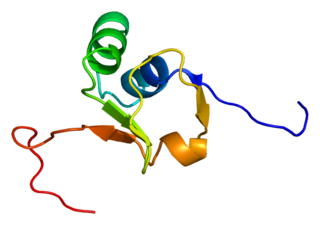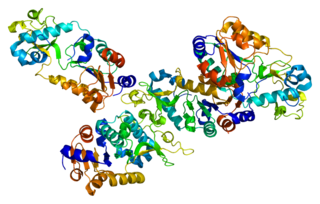
U3 small nucleolar ribonucleoprotein protein IMP3 is a protein that in humans is encoded by the IMP3 gene.

Deubiquitinating protein VCIP135 is a protein that in humans is encoded by the VCPIP1 gene.

Ectonucleoside triphosphate diphosphohydrolase 6 is an enzyme that in humans is encoded by the ENTPD6 gene.

Semaphorin-4F is a protein that in humans is encoded by the SEMA4F gene.

N-acetyltransferase 10 is an enzyme that in humans is encoded by the NAT10 gene.

Beta-taxilin is a protein that in humans is encoded by the TXLNB gene.

CTTNBP2 N-terminal-like protein is a protein that in humans is encoded by the CTTNBP2NL gene. It is a substrate for phosphorylation.

Histone deacetylase complex subunit SAP130 is an enzyme that in humans is encoded by the SAP130 gene.

Sirtuin 5 , also known as SIRT5 is a protein which in humans in encoded by the SIRT5 gene and in other species by the orthologous Sirt5 gene.

Stannin is a protein that in humans is encoded by the SNN gene.

High-mobility group protein B3 is a protein that in humans is encoded by the HMGB3 gene.

Hippocalcin like 4, also known as HPCAL4, is a human gene.

AP-1 complex-associated regulatory protein is a protein that in humans is encoded by the AP1AR gene.

Probable ATP-dependent RNA helicase DDX43 is an enzyme that in humans is encoded by the DDX43 gene.

Synaptotagmin-13 is a protein that in humans is encoded by the SYT13 gene.

Secretory carrier-associated membrane protein 5 is a protein that in humans is encoded by the SCAMP5 gene.

DEP domain-containing mTOR-interacting protein (DEPTOR) also known as DEP domain-containing protein 6 (DEPDC6) is a protein that in humans is encoded by the DEPTOR gene.

Zinc finger protein 34 is a protein that in humans is encoded by the ZNF34 gene.

Kelch-like protein 18 is a protein that in humans is encoded by the KLHL18 gene.

Leiomodin-3 is a protein that in humans is encoded by the LMOD3 gene. Leiomodin-3 is especially present at the pointed end of muscle thin filaments.


















